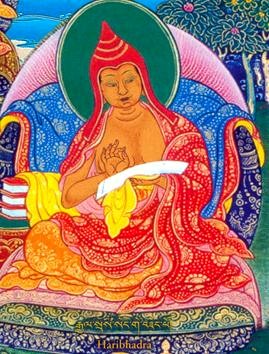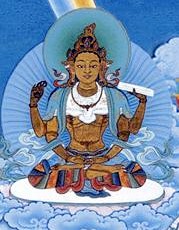Abhisamayalankara

Abhisamayalankara (Skt. Abhisamayālaṃkāra; Tib. མངོན་རྟོགས་རྒྱན་, Ngöntok Gyen, Wyl. mngon rtogs rgyan; Trad. Chin. 現觀莊嚴論), The Ornament of Clear Realization — one of the five treatises that were directly revealed to Asanga by the future Buddha Maitreya in 4th century. It is a commentary on the hidden meaning of the Prajñaparamita Sutras, describing the entire journey of the bodhisattva, from the generation of bodhichitta to the attainment of full omniscience. It is included among the so-called "Thirteen great texts", which form the core of the curriculum in most shedras and on which Khenpo Shenga provided commentaries.

The text is divided into eight topics:
The Eight Topics
- knowledge of all aspects, omniscience (Skt. Sarvākārajñatā; Tib. རྣམ་ཀུན་མཁྱེན་ཉིད་, nam kun khyen nyi or རྣམ་མཁྱེན་, "namkhyen")
- path-knowledge (Skt. Mārgākārajñatā; Tib. ལམ་ཤེས་ཉིད་, lamshe nyi or ལམ་ཤེས་, lamshe)
- base-knowledge, knowledge of the bases, knowledge of the foundation (Skt. vastujñāna; Tib. གཞི་ཤེས་, zhishe) but also all-knowledge (Skt. Sarvajñatā; Tib. ཐམས་ཅད་ཤེས་པ་ཉིད་, tamche shepa nyi)
- complete application of all aspects, application of the realization of all aspects (Skt. Sarvākārābhisambodha; Tib. རྣམ་ཀུན་མངོན་རྫོགས་རྟོགས་པ་ but also རྣམ་རྫོགས་སྦྱོར་བ་, namdzog jorwa)
- culminating application, application when reaching the peak (Skt. Murdhābhisamaya; Tib. རྩེ་མོར་སྦྱོར་བ་, tsemor jorwa)
- progressive application, gradual training, gradual application of the bodhisattva path (Skt. Anupurvābhisamaya; Tib. མཐར་གྱིས་པའི་སྦྱོར་བ་, thar gyi jorwa)
- instantaneous application, momentary training (Skt. Ekakṣanābhisamaya; Tib. སྐད་ཅིག་མའི་སྦྱོར་བ་, kechigme jorwa)
- dharmakaya (Skt. dharmakāya but also Dharmakāyābhisambodha; Tib. ཆོས་སྐུ་, chö ku, Wyl. chos sku)
These eight topics are further divided into seventy points.
Quotations
Definition of Bodhichitta
ཡང་དག་རྫོགས་པའི་བྱང་ཆུབ་འདོད། །
Arousing bodhicitta is: For the sake of others,
Longing to attain complete enlightenment.
Not a thing to be removed, nothing to be added
གཞག་པར་བྱ་བ་ཅུང་ཟད་མེད། །
ཡང་དག་ཉིད་ལ་ཡང་དག་ལྟ། །
In this, there is not a thing to be removed,
Nor the slightest thing to be added.
It is looking perfectly into reality itself,
And when reality is seen, complete liberation.
- Maitreya, Ornament of Clear Realization, V, 21 and Sublime Continuum, I, 154[1]
Text
The Tibetan translation of the text can be found in the Dergé Tengyur, Toh 3786.
Commentaries
Indian
In his commentary on the Abhisamayalankara Mipham Rinpoche says that among the texts in the Tibetan Tengyur related to the prajnaparamita, there are twenty-one Indian commentaries on the Ornament of Clear Realization.
- 1. Arya Vimuktisena, Illuminating the 25,000 Verses (Skt. abhisamayālaṅkārakārikāvārttika, Tib. ཉི་ཁྲི་སྣང་བ་, nyi khri snang ba, or more fully
 ཤེས་རབ་ཀྱི་ཕ་རོལ་ཏུ་ཕྱིན་པ་སྟོང་ཕྲག་ཉི་ཤུ་ལྔ་པའི་མན་ངག་གི་བསྟན་བཅོས་མངོན་པར་རྟོགས་པའི་རྒྱན་གྱི་ཚིག་ལེའུར་བྱས་པའི་རྣམ་པར་འགྲེལ་པ་, shes rab kyi pha rol tu phyin pa stong phrag nyi shu lnga pa'i man ngag gi bstan bcos mngon par rtogs pa'i rgyan gyi tshig le'ur byas pa'i rnam par 'grel pa
ཤེས་རབ་ཀྱི་ཕ་རོལ་ཏུ་ཕྱིན་པ་སྟོང་ཕྲག་ཉི་ཤུ་ལྔ་པའི་མན་ངག་གི་བསྟན་བཅོས་མངོན་པར་རྟོགས་པའི་རྒྱན་གྱི་ཚིག་ལེའུར་བྱས་པའི་རྣམ་པར་འགྲེལ་པ་, shes rab kyi pha rol tu phyin pa stong phrag nyi shu lnga pa'i man ngag gi bstan bcos mngon par rtogs pa'i rgyan gyi tshig le'ur byas pa'i rnam par 'grel pa
- English translation: Commentary for the Ornament (abhisamayālaṅkāra vṛtti, in Abhisamayalamkara with Vritti by Arya Vimuktisena and Aloka by Haribhadra, translated by Gareth Sparham, 2005.
- 2. Bhadanta Vimuktisena, Commentary on the 25,000, ( 'phags pa shes rab kyi pha rol tu phyin pa stong phrag nyi shu lnga pa'i man ngag gi bstan bcos mngon par rtogs pa'i rgyan gyi tshig le'ur byas pa'i rnam par 'grel pa)
- 3. Smirtijnana, Teaching on the Three Renowned ‘Mother’ Scriptures in Conformity with the Eight Points ( 'bum dang nyi khri lnga stong pa dang khri brgyad stong pa gsum don mthun par mngon rtogs brgyad du bstan pa)
- 4. Haribhadra, Eight Chapters on the 25,000, (shes rab kyi pha rol tu phyin pa stong phrag nyi shu lnga pa). This text comprises three volumes in the Tengyur.
- 5. Haribhadra, Light Ornament: A Great Commentary on the 8,000 Verses ( 'phags pa shes rab kyi pha rol tu phyin pa brgyad stong pa'i bshad pa mngon par rtogs pa'i rgyan gyi snang ba)
- English translation: Light for the Ornament: An Explanation of the Perfection of Wisdom (Abhisamayālaṃkārā lokā prajñā pāramitā vyākhyā), in Abhisamayalamkara with Vritti by Arya Vimuktisena and Aloka by Haribhadra, translated by Gareth Sparham, 2005.
- 6. Haribhadra, Commentary on the Difficult Points of the Condensed Sūtra (bcom ldan 'das yon tan rin po che sdud pa'i tshigs su bcad pa'i dka' 'grel)
- 7. Haribhadra, Illuminating the Meaning, Sphutartha (Skt. Sphuṭārthā; Tib. འགྲེལ་པ་དོན་གསལ་, Wyl. 'grel pa don gsal, or more fully shes rab kyi pha rol tu phyin pa'i man ngag gi bstan bcos mngon par rtogs pa'i rgyan zhes bya ba'i 'grel pa).
 མངོན་རྟོགས་རྒྱན་གྱི་འགྲེལ་པ་དོན་གསལ་, mngon rtogs rgyan gyi 'grel pa don gsal. Mipham Rinpoche tells us that Haribhadra composed this commentary after having received a prophecy from buddha Maitreya. This became the most famous commentary in Tibet.
མངོན་རྟོགས་རྒྱན་གྱི་འགྲེལ་པ་དོན་གསལ་, mngon rtogs rgyan gyi 'grel pa don gsal. Mipham Rinpoche tells us that Haribhadra composed this commentary after having received a prophecy from buddha Maitreya. This became the most famous commentary in Tibet.
- 8. Dharmakirti of Suvarnadvipa, Light on the Difficult-to-Comprehend (mngon par rtogs pa'i rgyan zhes bya ba'i 'grel pa rtogs par dka' ba'i snang ba zhes bya ba'i 'grel bshad), which is a sub-commentary on Haribhadra's Sphutartha.
- 9. Dharmamitra, Explanatory Commentary Clarifying the Words (Skt. Abhisamayālaṅkāra kārikā prajñā pāramitopadeśa śāstra ṭīkā prasphuṭa padā, Tib. shes rab kyi pha rol tu phyin pa'i man ngag gi bstan bcos mngon par rtogs pa'i rgyan gyi tshig le'ur byas pa'i 'grel bshad tshig rab tu gsal ba), which is also a sub-commentary on Haribhadra's Sphutartha.
- 10. Buddha Shri Jnana, Commentary on the Difficult Points of the Condensed Sūtra (sdud pa tshigs su bcad pa'i dka' 'grel)
- 11. Ratnakirti, kīrtikalā (Skt. Abhisamayālaṅkāra vṛtti kīrtikalā, Tib. mngon par rtogs pa'i rgyan gyi 'grel pa grags pa'i cha)
- 12. Kashmiri Buddha Shri Jnana, Rosary of Liberating Wisdom (mngon rtogs rgyan gyi 'grel pa shes rab sgron ma'i phreng ba)
- 13. Ratnakarashanti, Pure 25,000 (mngon par rtogs pa'i rgyan gyi tshig le'ur byas pa'i 'grel pa dag ldan)
- 14. Kashmiri Dharma Shri, Explanation of the 100,000 (stong phrag brgya pa'i rnam par bshad pa)
- 15. Ratnakarashanti Supreme Essence ( 'phags pa shes rab kyi pha rol tu phyin pa brgyad stong pa'i dka' 'grel snying po mchog)
- 16. Atisha, Lamp of Essential Meaning, (shes rabs kyi pha rol tu phyin pa'i don bsdus sgron ma)
- 17. Abhayakaragupta, Moonlight of Points (Skt. Aṣṭa sāhasrikā prajñāpāramitā vṛtti marmakaumudī, 'phags pa shes rab kyi pha rol tu phyin pa brgyad stong pa'i 'grel pa gnad kyi zla ba'i 'od)
- 18. Kashmiri Dharma Shri, Key to the Treasury of Transcendent Wisdom (shes rab kyi pha rol tu phyin pa'i mdzod kyi lde mig)
- 19. Prajnakaramati, Essential Meaning (mngon par rtogs pa'i rgyan gyi 'grel pa'i bsdus don), which is also a sub-commentary on Haribhadra's Sphutartha.
- 20. Kumara Shri Bhadra, Essential Meaning ((Skt. Prajñā pāramitā piṇḍārtha, Tib. shes rab kyi pha rol tu phyin pa'i don bsdus pa)
- 21. Mipham Rinpoche gives the text as Düpé Damngak (sdud pa'i gdams ngag), but Khenpo Tsondru says it is Abhayakaragupta's Munimatālaṅkāra (Tib. thub pa'i dgongs pa'i rgyan, Toh 3903). The later text is, unlike all the other twenty texts, not found in the prajnaparamita section of the Tengyur but the madhyamaka section.
Tibetan
| This section contains Tibetan script. Without proper Tibetan rendering support configured, you may see other symbols instead of Tibetan script. |
- Tsongkhapa, Golden Garland of Eloquence (ལེགས་བཤད་གསེར་ཕྲེང་, legs bshad gser phreng) (translated by Gareth Sparham, Jain Publishing, 2008)
 མངོན་རྟོགས་རྒྱན་འགྲེལ་ལེགས་བཤད་གསེར་འཕྲེང་ལས་རྣམ་པ་ཐམས་ཅད་མཁྱེན་པ་ཉིད་ཀྱི་སྐབས་, mngon rtogs rgyan 'grel legs bshad gser 'phreng las rnam pa thams cad mkhyen pa nyid kyi skabs
མངོན་རྟོགས་རྒྱན་འགྲེལ་ལེགས་བཤད་གསེར་འཕྲེང་ལས་རྣམ་པ་ཐམས་ཅད་མཁྱེན་པ་ཉིད་ཀྱི་སྐབས་, mngon rtogs rgyan 'grel legs bshad gser 'phreng las rnam pa thams cad mkhyen pa nyid kyi skabs
- Patrul Rinpoche, Overview
- Pöpa Tulku, The Oral Transmission of the Invincible Maitreya and An Adornment to the Vision of the Invincible Maitreya
 ཤེར་ཕྱིན་མངོན་པར་རྟོགས་པའི་རྒྱན་གྱི་ཚིག་དོན་རྣམ་པར་བཤད་པ་མ་ཕམ་ཞལ་ལུང་, sher phyin mngon par rtogs pa'i rgyan gyi tshig don rnam par bshad pa ma pham zhal lung
ཤེར་ཕྱིན་མངོན་པར་རྟོགས་པའི་རྒྱན་གྱི་ཚིག་དོན་རྣམ་པར་བཤད་པ་མ་ཕམ་ཞལ་ལུང་, sher phyin mngon par rtogs pa'i rgyan gyi tshig don rnam par bshad pa ma pham zhal lung ཤེར་ཕྱིན་གྱི་ཟིན་བྲིས་, sher phyin gyi zin bris
ཤེར་ཕྱིན་གྱི་ཟིན་བྲིས་, sher phyin gyi zin bris
- Amdo Geshe Jampal Rolwé Lodrö, The Essence of an Ocean of Fine Explanation
- Mipham Rinpoche ཤེར་ཕྱིན་མངོན་རྟོགས་རྒྱན་གྱི་མཆན་འགྲེལ་པུཎྜ་རི་ཀའི་དོ་ཤལ།, sher phyin mngon rtogs rgyan gyi mchan 'grel puN+Da ri ka'i do shal
 ཤེར་ཕྱིན་མངོན་རྟོགས་རྒྱན་གྱི་མཆན་འགྲེལ་པུཎྜ་རི་ཀའི་དོ་ཤལ།་, sher phyin mngon rtogs rgyan gyi mchan 'grel puN+Da ri ka'i do shal
ཤེར་ཕྱིན་མངོན་རྟོགས་རྒྱན་གྱི་མཆན་འགྲེལ་པུཎྜ་རི་ཀའི་དོ་ཤལ།་, sher phyin mngon rtogs rgyan gyi mchan 'grel puN+Da ri ka'i do shal
Translations
- Abhisamayalankara, Edward Conze (Rome: Is.M.E.O., 1954).
- Gone Beyond: The Prajnaparamita Sutras, The Ornament of Clear Realization, and Its Commentaries in the Tibetan Kagyu Tradition, Volume One, translated and introduced by Karl Brunnhölzl (Ithaca: Snow Lion, 2011)
- Gone Beyond: The Prajnaparamita Sutras, The Ornament of Clear Realization, and Its Commentaries in the Tibetan Kagyu Tradition, Volume Two, translated and introduced by Karl Brunnhölzl (Ithaca: Snow Lion, 2011)
- Groundless Paths: The Prajnaparamita Sutras, The Ornament of Clear Realization, and Its Commentaries in the Tibetan Nyingma Tradition, translated and introduced by Karl Brunnhölzl (Ithaca: Snow Lion, 2012)
- Ornament of Clear Realization: A Commentary on the Prajnaparamita of Maitreya, Thrangu Rinpoche (Zhyisil Chokyi Ghatsal, 2004)
- Abhisamayalankara (mngon rtogs rgyan), Maitreya – Asanga with commentary by Jamgön Mipham, Padmakara translation group, forthcoming
References
- ↑ This is also verse 7 of Nāgārjuna’s Heart of Dependent Origination.
Teachings Given to the Rigpa Sangha
- Dzigar Kongtrul Rinpoche – Rigpa Shedra West, Dzogchen Beara, 2003
- Dzogchen Rinpoche – Rigpa Shedra West, Dzogchen Beara, 2004
- Khenpo Jampal Dorje – Rigpa Shedra West, Lerab Ling, 2005
- Khenpo Sönam Tobden - Rigpa Shedra East, 4 January to 30 April 2011
- Lopön Penpo Tsering, Rigpa Shedra East, 2017
Further Reading
- John Makransky, Buddhahood embodied: sources of controversy in India and Tibet, New York: SUNY, 1997
- James B. Apple, Stairway to Nirvana: A Study of the Twenty Samghas Based on the Works of Tsong kha pa, SUNY, 2008
- James B. Apple, Contributions to the Development and Classification of Abhisamayālaṃkāra Literature in Tibet from the Ninth to Fourteenth Centuries, JIATS, no. 5 (December 2009), available online here
Internal Links
External Links
 Prologue to Abhisamayalankara Commentary by Khenchen Shenga
Prologue to Abhisamayalankara Commentary by Khenchen Shenga The 70 Points of the Abhisamayalankara by Khenpo Tsöndrü
The 70 Points of the Abhisamayalankara by Khenpo Tsöndrü Prajnaparamita Series on Lotsawa House
Prajnaparamita Series on Lotsawa House- Audio Archives of Oral commentary on Jamyang Shaypa's "Eloquent Presentation of the Eight Categories and Seventy Topics" by Denma Locho Rinpoche translated by Jeffrey Hopkins
